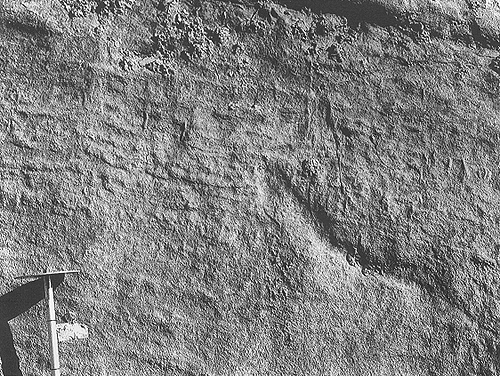
Dish-and-pillar structure
Plate 114

Dish-and-pillar structure
Plate 114
In weakly cemented sandstones, dish structure is emphasized by differential lithification. More cement was precipitated where the sediment was more permeable, in between matrix-rich films. Dishes are here associated with pillar structures, sort of small dikes cutting through bedding; some of them are short and blind, some others reach the bed top. Pillars are the better cemented portions of the bed and represented preferential routes of water escape during bed accumulation. Sand grains were probably lifted up by elutriation along them.
Summarizing, a tripartite zonation can be made in this bed: 1) the lower part is almost structureless; it probably underwent liquefaction and constituted the main source of escaped water; 2) in the intermediate portion, about 20 cm thick (see Jacob staff for scale), dish structure is predominant with some hints of pillars; 3) in the upper portion, dishes are subdued whereas pillars are standing out. The oblique ridge at midsection is a blind injection of larger size, sort of dike.
This is one more example of a "proximal" turbidite bed in the Marnoso-arenacea Formation near Sarsina, northern Apennines.; It must be stressed, however, that dish and water escape structures are found also in shallow-water, littoral, and fluvial sands. They are indicators of process, not of environment. One of the conditions for their development, the poor, unstable packing of sand grains, can be attained in more than one way: rapid deposition by a catastrophic process is one of them; others can be provided by post-depositional disturbances, such as sediment churning by organisms, seismic shocks, fluctuations of pore pressure due to the passage of storm waves.
Marnoso-arenacea Formation, Umbro-Casentinese Road, Romagna.